 |
Ivangorod Fortress
Ivangorod, Leningrad Oblast, Russia
|
|
 |
Constructed: 1492-1558
Used by: Russia, Sweden,
Germany, Republic of Estonia
Conflicts in which it participated:
First and Second
Muscovite-Lithuanian Wars, Livonian War,
Russian-Swedish War
Also known as: Ивангородская крепость
|
The Narva River drains Lake Peipus into the Baltic Sea. The river is only 48 miles long, but it's deep 'n' wide, and has supported much travel and trade in the region since the Viking age (5th to 11th century), and likely long before. |
 |
|
|
The Narva has historically been the border betwixt Livonia and Novgorod, and folks inevitably settled on either side of the Narva Waterfall, where riverfarers were forced to exit their craft and trod to the next navigable bit of river.
In the interest of securing this portage-ish area, the Danes, at the time the masters of what is today Estonia, built a wooden stronghold on the west side of the river in the 13th century. At the beginning of the 14th century, the stone Hermann Castle was built, presumably by those same Danes...or at least descendant Danes of those Danes who built the wooden thing. Folks started building around this castle, and the town of Narva was founded in 1345.
|
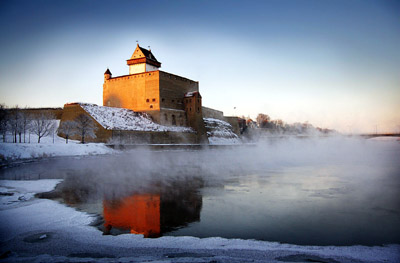 Hermann Castle, facing Ivangorod Fortress across the Narva River. And some snow. Hermann Castle, facing Ivangorod Fortress across the Narva River. And some snow. |
 |
No sooner had Narva officially become a town than the Livonian Teutonic Knights moved in, clanking and whirring in their clockwork suits of armor. The Teutonic Knights were a military arm of the Catholic Church, formed in 1190 to protect folks traveling on pilgrimages to the Holy Land during the Middle Ages. The Livonian branch of the Teutonic Order was founded in 1237, and mostly did their sword-swinging in what is today Latvia and Estonia.
When the Livonian Order bought northern Estonia from the Danes in 1347, they reconfigured Hermann Castle to serve as a convent building...and they later erected the castle's most striking feature, the Hermann Tower, which still looms in a relatively squatty manner over the Narva today. |
|
...and why was it necessary to build such a tower in a convent in 1492, as well as construct a wall around the whole town? Because of Ivangorod Fortress! The Russians on the other side of the Narva did the only sensible thing to do when one's opposite numbers across a relatively narrow river have a fort: They built one of their own! Though not a starfort in the classic sense as it exists today, Ivangorod Fortress is a semi-bastioned (towered?) fort, and started its long life as a dinky little pre-starfort.
|
1492 would have been very early for a starfort in any place other than Italy...the Trace Italienne was still being developed in Italy in the last years of the 15th century. But, if you'd be so kind as to look at the lower left of the image at the top of this page (or just to the right of this paragraph, if you're lazy), you will see what appears to be unquestionable starfort evidence.
Based on the picture to the right, I initially thought that the original Ivangorod Fortress was a starfort: Those sure do look like the remains of bastions, don't they? Sadly, those are actually the remains of square towers. Who cares, you may well ask, aren't towers still bastions? Sort of, but the starfort purist would violently shake his (or her) head at such a suggestion.
|
 |
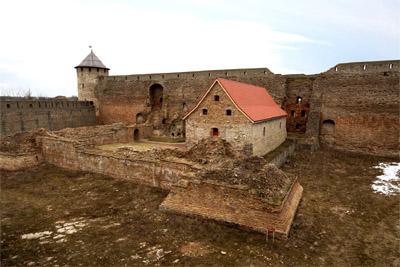 What's left of the original Ivangorod Fortress! The fort was expanded in 1496 after the original had been determined to be too small to support a garrison large enough to defend it: One wall of the new part of the fort joined with the original wee pre-starfort. What's left of the original Ivangorod Fortress! The fort was expanded in 1496 after the original had been determined to be too small to support a garrison large enough to defend it: One wall of the new part of the fort joined with the original wee pre-starfort. |
|
Ivangorod Fortress was, unsurprisingly, named for someone named Ivan. In this case that person named Ivan was Ivan III (1440-1505), also known as Ivan the Great. Mr. Great ordered its construction in the summer of 1492, as the Muscovites and Lithuanians had increasingly been getting in one anothers' way due to the rapid Russian expansion for which Ivan III is so fondly remembered, and he knew that war was coming. Not just with the Livonians, but with Sweden as well.
|
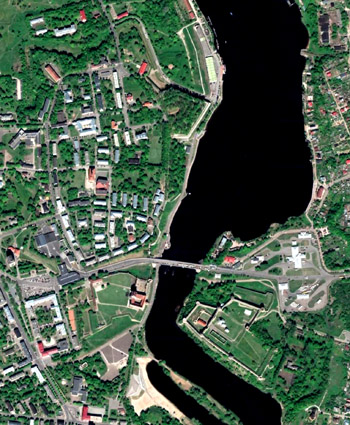 A look at Ivangorod Fortress' surrounding area shows the remains of two Estonian starforts on the other side of the Narva! That's Hermann Castle directly across the river from Ivangorod, and Vasknarva Fortress a smidge to the north on the western bank. A look at Ivangorod Fortress' surrounding area shows the remains of two Estonian starforts on the other side of the Narva! That's Hermann Castle directly across the river from Ivangorod, and Vasknarva Fortress a smidge to the north on the western bank. |
 |
The spunky little Ivangorod Fortress was positioned wisely at a sharp bend in the river, protecting it on three sides. Being the size it was, however, it was unable to support much of a garrison, of which the Swedes took note.
In 1496, 70 ships from Copenhagen, carrying 5,000 men with ultra-modern, magical firearms, landed on the eastern bank of the Narva and set about assaulting Ivangorod...and within seven hours our wee little fort was in the hands of the Swedes. The Russian army was encamped "not far" from Ivangorod, but pointedly did not rush to the garrison's aid, correctly figuring that the fort couldn't hold out long enough for the army's arrival.
The victorious Swedes offered to give Ivangorod Fortress to the Livonian Order, who said "what, that tiny little thing? You guys can keep it." When the Russian army finally got around to heading in their direction, however, the Swedes decided they didn't particularly want it either, and departed with 300 prisoners.
While the Swedes had been encouraged to leave, they had made clear the defect in Ivangorod Fortress' design. A larger fort was obviously needed to hold this position, so the Russians killed a horse. |
|
Legend has it that the size of the next iteration of Ivangorod Fortress was determined by stretching a leather ribbon made from the hide of a single horse, and seeing how much of a wall could be laid out within a boundary shaped with its length. Which seems a tad arbitrary, but I guess one needs to use some rule of thumb (hoof)...and this was a completely new fortification, not just a reworking of previously-established fortifications or walls, which was how the size of most new fortifications were determined at that time and place.
The new Ivangorod Fortress was swiftly constructed in 1496 with relatively thin curtain walls connecting square bastionish towers. Inside the fort were built three interior walls, which divided it into four equal-ish sections: Defense in depth! Its northwestern wall joined the original little pre-starfort, so that continued to be the pugnacious point that faced across the Narva. The beefed-up Ivangorod Fortress (with a much larger garrison) withstood a siege in 1502, during the Second Muscovioite-Lithuanian War (1500-1502). Who was doing the besieging? Lithuanians? The Livonian Order? More of those darned Swedes? Unclear.
|
Improvements and expansion took place through the first half of the 16th century. The original Ivangorod Fortress was enclosed with walls that went right to the edge of the river, making a landing impossible at that point. This part of the fort was called the Castle, or more likely, Замок. As the fort expanded to the north and east, those newer sections became known by the snappy name of Big Boyarsky Town.
Russians of the 16th century were almost as serious about religion as were the Spanish, so getting a church into Ivangorod was a high priority. This was achieved with the construction of the Nikolskaya Church around 1500, and the Church of the Assumption of the Blessed Virgin sometime later in the 16th century.
|
 |
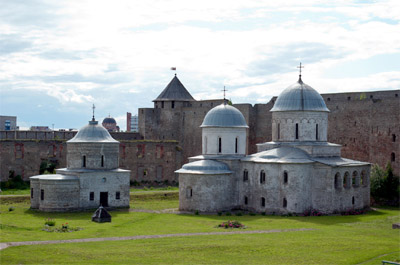 The Nikloskaya Church sits to the left. For some reason it was determined that any worthwhile fort had to have more than just one church, and the larger Church of the Assumption of the Blessed Virgin was built right next to the Nikloskaya. The Nikloskaya Church sits to the left. For some reason it was determined that any worthwhile fort had to have more than just one church, and the larger Church of the Assumption of the Blessed Virgin was built right next to the Nikloskaya. |
|
The Swedes came back with a vengeance in 1581, and after repeated attempts, managed to capture Ivangorod Fortress and Narva Castle, both of which they held for the next ten years. Then they got bored and left.
Internal power struggles weakened Russia during the "Time of Troubles" in the first decades of the 17th century, so much so that they allied with Sweden for a period, because Sweden was at war with Poland, which seemed like a good idea at the time to Russia. This naturally blew up in their bearded faces when that alliance collapsed and the Russo-Swedish War (1610-1617) commenced. Re-commenced? The 15th through 17th centuries seem so crammed with conflicts in which Russia fought with Sweden that it kind of seems like one lengthy exhausting war, but then that's what all of European history seems like in this period. Europe really should have separated and figured out how to put some large bodies of water betwixt each nation.
Back in the real world, the Swedes yet again captured Ivangorod Fortress in 1612, and hung onto it until the end of the war...at which time the Stoblovsky Peace (1617), a treaty that spelled out the conditions under which that war would be discontinued, officially gave Ivangorod to Sweden. This was the case for the next hundred years. Almost.
|
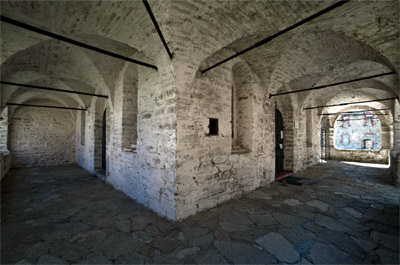 Some of Ivangorod's inner splendor: Based on the view outside the opening on the right, this looks like it's in the second-to-most-northwestern bastion on the river side of the fort. Beautiful!!! Some of Ivangorod's inner splendor: Based on the view outside the opening on the right, this looks like it's in the second-to-most-northwestern bastion on the river side of the fort. Beautiful!!! |
 |
As was common for many a non-active fort, Ivangorod Fortress was utilized by the Swedes as a prison during this period...perhaps only for the upper-crusty sort of prisoners, as Jakob von Kettler (1610-1682), Duke of Courland, was imprisoned at the fort of our current interest from 1659 to 1660 with his family, and Dukes with their families weren't generally kept in low-end prisons.
The Great Northern War (1700-1721) saw Russia and her allies (including, at various periods of this conflict: Prussia, Britain, Poland and the Netherlands) challenging Sweden's dominance in Northern and Central Europe. |
|
Peter the Great (1672-1725), another Russian ruler remembered with affection at least partially due to his expansionist tendencies, captured Ivangorod Fortress from the Swedes in 1704.
Ivangorod Fortress' two lovely churches were affected radically each time the fort changed hands. They naturally began their career as Russian Orthodox, but when the Swedes were in charge, the churches were reconsecrated to Lutheran. Apparently flipping the switch back to Orthodox was too complicated: When Russia reobtained Ivangorod Fortress in 1704, the churches were closed for the next 40 years.
|
An assessment of border fortifications in the 1730's determined that Ivangorod Fortress wasn't up to snuff for the purpose of defending the motherland from its foes. Catherine the Great (1729-1796) ordered that its interior churches be re-incensed for Russian Orthodoxy in 1744, and improvements were made to the fort in 1840, 1863 and 1911-1915...more in the interest of maintaining an historically significant entity, it seems, than readying it for battle.
Germany was the next member of the exclusive We've Owned Ivangorod Fortress Club: They took possession of the fort in March of 1914, shortly after the start of the First World War (1914-1918).
|
 |
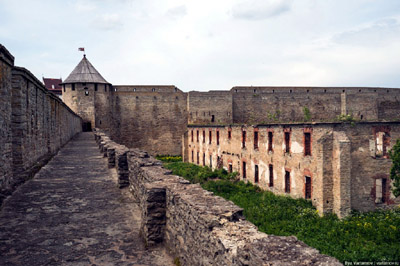 Looking northwest along the river side of Ivangorod Fortress...see Hermann Castle across the Narva, peeking over the wall at top left! Thanks for the image, Ilya Varlamov! Looking northwest along the river side of Ivangorod Fortress...see Hermann Castle across the Narva, peeking over the wall at top left! Thanks for the image, Ilya Varlamov! |
|
For a brief, shining period, there was a Republic of Estonia betwixt the World Wars. From 1918 to 1939 Ivangorod was considered part of the city of Narva, and whatever Estonia was using for a flag at the time flew over the fort. The Republic tried desperately to remain neutral in the leadup to the Second World War (1939-1945), but the Soviet Union and Nazis were having none of it, and the Molotov-Ribbentrop Act of 1939 set Estonia firmly within the Soviet sphere of influence. In June of 1940 the Soviet Union invaded, and hooray, Ivangorod Fortress danced a little jig of glee, because it belonged to Russia once again!
|
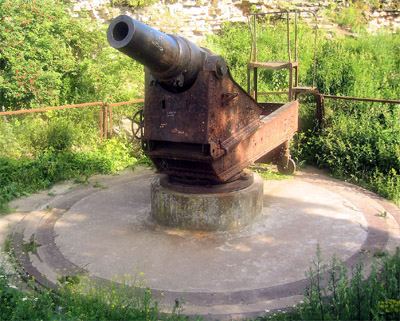 Clearly somebody thought Ivangorod Fortress might need some modern defendin', despite the 18th century determination that it was good for nothin'...as this howitzer within the fort dates to 1891. Clearly somebody thought Ivangorod Fortress might need some modern defendin', despite the 18th century determination that it was good for nothin'...as this howitzer within the fort dates to 1891. |
 |
And if you thought Ivangorod Fortress' two churches suffered from an identity crisis when they passed from the Russians to the Swedes, just imagine how they felt when they passed from the Estonians to the Soviets! Fortunately, the fortress' next owners were known far and wide for religious tolerance. And by "tolerance," I mean, "killed everybody."
The Nazis invaded Russia and Eastern Europe in 1941, and established two concentration camps within Ivangorod Fortress. Being sore losers, they destroyed as much of the fortress as they could before they were ejected in July of 1944: Six of its corner towers, some of its walls, its "cache" (powder magazine?) and churches were all substantially damaged in this process. |
|
Ivangorod Fortress remained a pile of ancient rubble for many years after the Second World War. A restoration effort centered on its interior churches took place between 1976 and 1985, however, and from 1987 to 1988 the Church of the Assumption of the Blessed Virgin was used as a concert hall.
Today, there aren't many interior structures left in Ivangorod Fortress, but its towers and walls have been restored, and those churches look absolutely lovely. There is still some issue regarding whom exactly owns Ivangorod and its fortress, as Estonia recognizes the borders set in 1920, which included Ivangorod as part of the city of Narva...but pretty much everyone else recognizes that Ivangorod is a Russian city, and Ivangorod Fortress a Russian fortress. At least Google Maps recognizes this, which is about as official as it can get!
|
  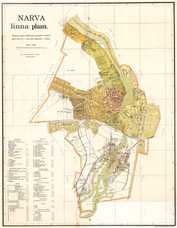 Above left:Ivangorod Fortress as viewed from across the Narva in 1616 Above left:Ivangorod Fortress as viewed from across the Narva in 1616
Above right: Narva in 1929: See? It included Ivangorod!
Both of the starforts on the western side of the river seem to have coalesced into one, called Sudalinn.
Below left: Ivangorod's coat of arms, whose representation of the fortress seems more interested in symmetry than accuracy.
But to be fair, it would be hard to not go with symmetry under a perfectly symmetrical two-headed eagle!
Below right: Ivangorod Fortress numero uno, thoughtfully provided by Russian starfort expert Gavrilenko Philippe.
Thanks, Gavrilenko! |
|
|
|
|
|
 |




